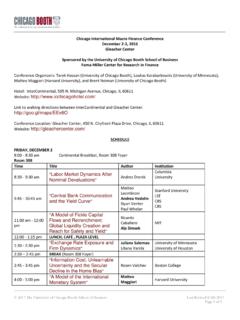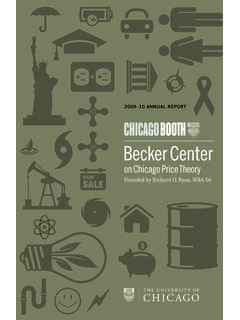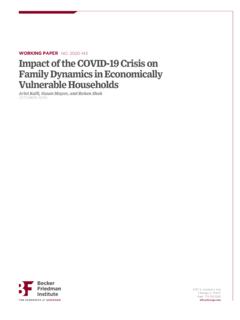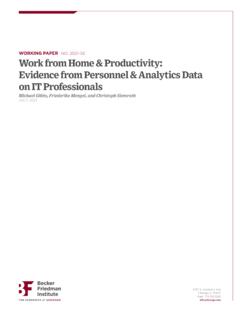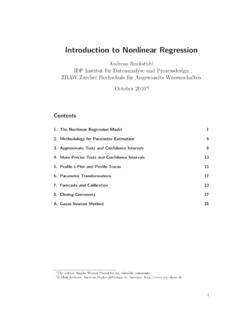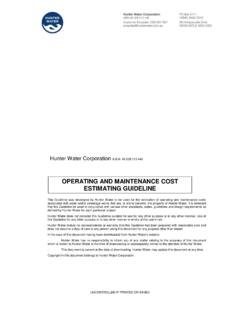Transcription of The Impact of the COVID-19 Pandemic on Consumption ...
1 1 The Impact of the COVID-19 Pandemic on Consumption : Learning from High Frequency Transaction Data* Haiqiang Chen, Wenlan Qian, and Qiang Wen April 14, 2020 * We benefit from valuable comments by Sumit Agarwal, Yi Huang, Chen Lin, Qin Yu, Johan Sulaeman, Dragon Tang, Peifeng Wang, and Liyan Yang. We also thank China UMS for its generous help in providing the transaction data and Muqing Song, Linyu Li for the excellent research assistance. Chen: Wang Yanan Institute for studies in Economics, Department of Finance, School of Economics, Xiamen University, Xiamen 361005, China Qian (corresponding author): Department of Finance, NUS Business School, National University of Singapore, 15 Kent Ridge Drive, Singapore, 119245 (email: Wen: Wang Yanan Institute for studies in Economics, School of Economics, Xiamen University, Xiamen 361005, China Chen acknowledges the financial support from National Natural Science Foundation of China Grants (#71850011, #71571152).)
2 1 The Impact of the COVID-19 Pandemic on Consumption : Learning from High Frequency Transaction Data Abstract: We use daily transaction data in 214 cities to study the Impact of COVID-19 on Consumption after China s outbreak in late January 2020. Based on difference-in-differences estimation , daily offline Consumption via UnionPay card and QR scanner transactions fell by 42%, or million RMB per city, during the eight-week period. Spending on goods and services were both significantly affected, with a decline of 44% and 43%, respectively; within finer categories, dining & entertainment and travel saw the greatest dip of 72% and 64%. All 214 cities experienced significant Consumption decreases, with magnitudes ranging from 14% to 69%. Consumption responded negatively to the day-to-day changes in epidemic severity with distancing measures remaining stable.
3 By late March 2020, the Consumption response shrank to -31%, a 36% improvement over the lowest point. We infer that China s offline Consumption decreased by over 1 trillion RMB in the two-month post-outbreak period, or 1% of China s 2019 GDP. Our estimates also imply reducing the time to reach the new cases apex by 10 days lessens the negative Consumption Impact by 6%. Keywords: COVID-19 , coronavirus, Pandemic , Consumption , economic Impact , policy response, fiscal stimulus, transaction data JEL codes: E21, E62, E61 1 1. Introduction On March 12, 2020, the World Health Organization announced COVID-19 outbreak as Pandemic . By early April 2020, COVID-19 had infected more than 1 million people worldwide in 204 countries, with over 55,000 deaths. Countries around the globe have increasingly implemented strict public health measures to respond to the outbreak.
4 These measures range from social distancing to a complete lockdown, invariably constraining economic activities with serious ramifications. Many governments have rolled out gigantic fiscal stimulus packages, as large as over 10% of the country s GDP, to help combat the negative economic consequences of COVID-19 . New support packages will likely be added as we delve further into the Pandemic . An ongoing debate centers on finding adequate measures that balance public health efforts to contain the coronavirus with economic interventions to neutralize the economic consequences. A major economic woe is firms immediate cashflow pressure from the sudden halt in economic activities, leading to massive unemployment and business shutdown that feed back into aggregate demand. It underlies a significant cost to enforce strict public health measures to contain the spread.
5 At the same time, knowledge is inconclusive concerning the transmission mode, rate of spread, and lethality, and no effective medical cure of the novel coronavirus exists, making projecting the course of the Pandemic difficult. The huge uncertainty directly hurts consumers willingness to consume when they feel unsafe and anxious, even with no imminent threat of economic security. The reduction in consumer demand as a direct result of the Pandemic will therefore create a rippling effect on the macroeconomy. Such intricacies add to the challenge of policy responses, compounded by the lack of a good understanding of the magnitude and source of the problem due to the unprecedented nature of the event in the past century. This paper provides direct evidence on the immediate economic Impact of COVID-19 , drawing upon China s experience to date.
6 China offers a good setting to assess the economic Impact of COVID-19 . It was the first country to experience a large-scale outbreak, starting in January 2020, which renders a sufficiently long post-outbreak period and thus statistical power for us to obtain credible estimation . By the end of March, China had reported 81,554 COVID-19 cases with 3,312 deaths. Significant geographic variation exists in the epidemic exposure across cities: the epicentre city, Wuhan, accounts for 61% of the total reported cases, whereas 32 cities had reported 0 cases by the end of March. The Chinese government implemented draconian measures to contain the 2 spread, including locking down Wuhan on Jan 23, 2020. Other cities also used strict measures to distance the population, and to trace and isolate suspected COVID-19 patients as well as closing non-essential service businesses, which other infected countries or regions subsequently adopted to a varying degree.
7 Facts about the economic Impact of COVID-19 in China are valuable as other countries are starting to go through a similar experience with COVID-19 . An additional advantage of the setting is that the outbreak started during the Chinese New Year (CNY) period most of the economic sectors were on holiday break suggesting a delayed Impact on the fundamentals of businesses and households and allowing us to isolate the direct effect of the epidemic. We focus on the Impact of COVID-19 on Consumption , which accounts for over 42% of China s GDP in the last decade (source: People s Bank of China, National Bureau of Statistics). We gain access to the universe of daily offline Consumption data recorded by card and QR scanner transactions through UnionPay. While E-Commerce has experienced accelerating growth in recent years, offline Consumption still constitutes 76% of China s overall retail Consumption (source: National Bureau of Statistics).
8 In addition, with brick-and-mortar retailers as major employers in the economy, studying offline Consumption provides a sharper assessment of the economic Impact of COVID-19 . UnionPay is China s largest payment service provider for offline spending serving over 1 billion people in the country (source: People s Bank of China). In 2019, the total offline Consumption recorded by UnionPay covers 30% of China s total retail Consumption offline (source: China UMS and National Bureau of Statistics). We collect daily offline Consumption at the city level from January to March 2020 for 214 prefecture-level cities, which cover 92% of China s 2018 GDP and 90% of the country s urban population. In addition to total spending, we observe Consumption by type (goods vs. services) and by category (daily necessities, durable goods, discretionary goods, dining & entertainment, travel-related, and others).
9 For the empirical analysis, we use the Wuhan lockdown date (January 23, 2020) as the start of the outbreak and compare the Consumption before and after. To capture the counterfactual Consumption pattern, we use the same period data in 2019 as the benchmark group. Instead of using the same calendar date to divide the 2019 sample, we use the lunar calendar to define the event date to account for the seasonal variation in Consumption related to the CNY period. January 23, 2020 was the day before CNY eve, and thus we use the corresponding lunar calendar date in 2019 as the cutoff to define the before and after period. In the difference-in-3 differences regressions, we include city, event-day, and day-of-week fixed effects to absorb unobserved city and time heterogeneity. Our objective is two-fold.
10 The first is to use the transaction-based Consumption measure to document and quantify the immediate Impact of COVID-19 on aggregate Consumption . How large is the Consumption decrease? For what type and categories of Consumption do we observe the greatest effect? How persistent is the Impact ? The second goal is to investigate the pattern of the Consumption Impact across space and over time in relation to the occurrence and severity of the epidemic outbreak. We exploit the data s high frequency and large cross section to detect the Consumption response to day-to-day changes in the epidemic development, whereas deterioration in macroeconomic conditions had not yet materialized and distancing measures stayed relatively stable in this short period. Thus, we can learn about the direct effect of the epidemic severity on Consumption .
